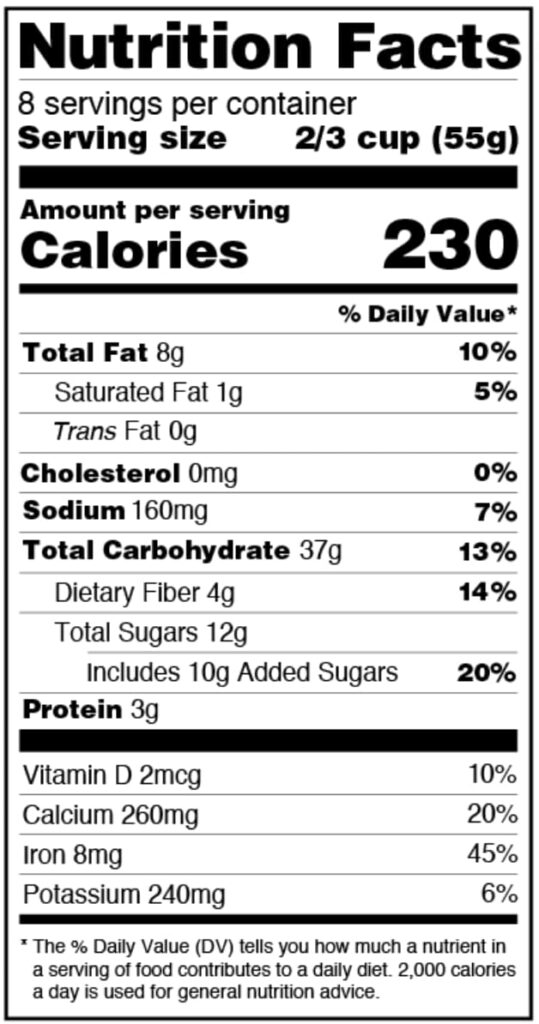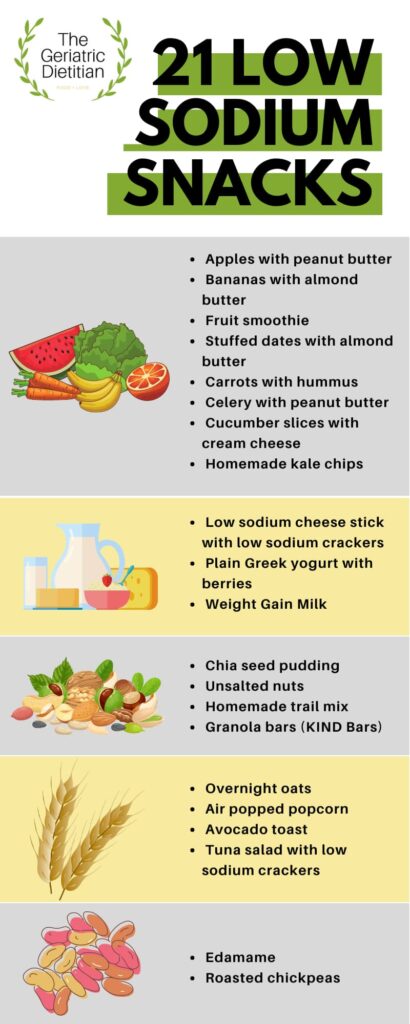21 Best Low Sodium Snacks [Dietitian Approved]
“21 Best Low Sodium Snacks [Dietitian Approved]” was written by Karina Herrera & edited/reviewed by Aly Bouzek, MS, RDN. Karina is a dietetic intern at Oregon Health & Science University.
In this article we will be discussing the importance of sodium and its role in our bodies, as well as consumption recommendations based on the Dietary Guidelines for Americans.
We’ll also learn how to read food labels and how to shop for ingredients to create some delicious recipes that are low in sodium and simple to prepare.
Let’s Learn About Sodium!
Let’s learn the difference between sodium and table salt and the impact sodium has on our health!
What is Sodium?
Are sodium and salt the same thing? Actually, they aren’t. Salt (or sodium chloride) is 40% sodium and 60% cholorde. Sodium is a mineral and one of the components of salt (remember the 40%)?
Sodium is added to foods for multiple reasons including: enhancing flavor, preserving freshness, and improving texture and appearance.
We need sodium to survive, but too much sodium can negatively affect our health.
Sodium Recommendations
The USDA’s Dietary Guidelines for Americans recommend that those over age 13, limit their sodium intake to less than 2,300 mg per day.
Note that the recommended sodium total is dependent on your age, your current health status, your past medical history, as well as other factors. Be sure to speak with your doctor to find an individualized sodium goal.
We now know what the recommendation for sodium is, but how much are Americans actually eating?
Those aged 1 year and older are actually consuming almost 3,400 mg of sodium (more than 80% of the recommended intake) per day. Additionally, the average range of sodium intake is between 2,000 to 5,000 mg per day. Wow!
Check out the chart below for some perspective on these stats and notice that 1 teaspoon of salt per day is about equal to the recommended 2,300 mg of sodium per day.
| Salt (sodium chloride) | Sodium |
| ¼ teaspoon | 575 mg |
| ½ teaspoon | 1,150 mg |
| 1 teaspoon | 2,325 mg |
| 1 ½ teaspoons | 3,475 mg |
| 2 teaspoons | 4,600 |
Sodium and Health
We need a small amount of sodium for essential body functions. With at least 500 mg per day, sodium assists with: maintaining water and electrolyte balance, nerve impulse function, and contracting and relaxing muscles.
Consuming too much sodium can increase blood pressure which can then lead to the development of heart problems. Some of these include: high blood pressure, stroke, heart attack, calcium loss, and heart failure.
People with specific medical disorders, such as heart failure, high blood pressure, and kidney disease are frequently advised to follow a low-sodium diet. Disclaimer: consult your healthcare team about the appropriate salt intake for you.
Sodium and Food Labels
All foods that have a Nutrition Facts label are required to list the amount of sodium in the food. To find the food label, turn the product over and follow these steps:
- Look to see how many servings there are per container. This will help determine how much sodium is in one serving of the food.
- Note the serving size. The serving size is shown as a common household measure that is appropriate to the food (such as cup, tablespoon, piece, slice, or jar).
- Next, look for “Sodium” about halfway down the label. The number of milligrams (mg) of sodium listed is the amount of sodium per serving size listed above on the food label.
- If you want to know how much sodium is in multiple servings, just multiply the sodium amount by the number of servings.
Let’s take a look together!

From this food label, we can see that there are 8 servings per this container of food. The serving size is ⅔ cups and the amount of sodium per ⅔ cups is 160 mg.
If you were wanting two servings of this food, then you would multiple the sodium content by the number of servings.
160 mg x 2 = 320 mg of sodium
So, 320 mg of sodium would be two servings, or 1 ⅓ cups, for this particular food. Always pay attention to servings per container, serving size, and sodium content to figure out how much sodium is in the food you’re eating.
Sodium Nutrient Claims
Sometimes, in the attempt to be helpful, companies will state that food products are “low sodium,” “salt-free,” etc. These are helpful tools, we just need to know what the claims mean. Here’s a helpful table on sodium nutrient claims.
| Nutrient Claim | Definition (per serving unless otherwise noted) |
| Salt-free, Sodium-free, No Sodium | Less than 5 mg of sodium and no ingredients contain sodium |
| Very low sodium | 35 mg or less of sodium |
| Low sodium | 140 mg or less of sodium |
| Reduced sodium | At least 25% less sodium than regular food product |
| Light (Lite) in Sodium | At least 50% less sodium than regular food product |
| Lightly Salted | 50% less sodium than regular food product |
| No-Salt-Added/Unsalted* | No salt added during processing*products may not be salt/sodium-free unless otherwise stated |
Finding Low Sodium Snacks
Finding snacks that are low in sodium can be tricky. But have no fear, we are going to explain some of the top high sodium snack culprits so that you’re prepared while grocery shopping!
Low Sodium Snack Ingredients: Buy or Pass By?
High sodium foods can include foods that are pre-packed and processed, but they can also be foods that are deemed “healthy.” Below, we’ve put together a few lists of common snack foods and which sodium category they would fall under.
Buy
In contrast, here is a list of common low sodium snack foods:
- Unsalted nuts and seeds
- Fruits and veggies (fresh and frozen – if canned, check food label for added sodium)
- Naturally low-sodium cheese (Swiss, goat, brick, ricotta, fresh mozzarella)
- Light or skim cream cheese
- Plain Greek yogurt
Pass By
Here is a list of common high sodium snack foods:
- Deli meats, canned meats
- Salted nuts
- Popcorn, crackers, chips
- Cheese, cottage cheese
- Pickles
Create Grocery List of Low Sodium Snacks
Making a grocery list ahead of time can help you find low sodium snacks that fit with your health goals. Without a prepared grocery list, you may find yourself leaning towards more processed foods (and those likely contain more sodium).
21 Best Low Sodium Snacks
We’ve picked out 21 delicious low sodium snacks and we hope you find a few that you’re excited about adding to your diet!
Fruits & Veggies (Don’t Forget the Dip!)
Fruits and veggies are naturally low in sodium. If you’re looking for a boost of flavor, try pairing the produce with a dip or nut butter. For low sodium snacks, make sure to watch the sodium content on nut butters and dips!
Here are some of our favorite low sodium options:
- Apples with peanut butter
- Bananas with almond butter
- Fruit smoothie (add some spinach for more nutrients)
- Stuffed dates with almond butter
- Carrots with hummus
- Celery with peanut butter
- Cucumber slices with cream cheese: watch sodium in cream cheese
- Homemade kale chips: swap added salt for herbs and spices instead
Dairy
Just because you’re looking for low sodium snacks, doesn’t mean that you have to sacrifice protein. Protein is so important – especially as we age. The snacks below have protein and are also low in sodium:
- Low sodium cheese stick with unsalted crackers
- Plain Greek yogurt with berries
- Weight Gain Milk
Nuts & Seeds
Nuts and seeds can be a great option for low sodium snacks. Again, watch the food label and opt for nuts and seeds that are lower in sodium or have little-to-no salt added.
Some suggestions include:
- Chia seed pudding
- Unsalted nuts
- Homemade trail mix: try a base of unsalted seeds, unsalted nuts, and some raisins or dried cranberries
- Granola bars: check sodium content if purchasing at a store – we enjoy KIND Bars
Grains
Grains are nutrient-dense and can provide protein, carbs, and fiber. Plus, they taste delicious! A few of our favorite low sodium snacks that contain grains are:
- Overnight oats
- Air popped popcorn: add some low sodium seasonings
- Avocado toast with low sodium bread
- Tuna salad with low sodium crackers: swap Greek yogurt or avocado in place of the mayo to help keep this snack low sodium
Beans
Beans might not seem like a “snack food,” but we’re here to suggest they might be! Not only are beans a great source of nutrients, but they are also packed with protein and fiber.
Our favorite bean snacks include:
- Edamame: try adding a splash of lemon juice for more flavor
- Roasted chickpeas: homemade or store-bought (watch sodium amount)
Low Sodium Snacks Conclusion

Low sodium snacks come in all shapes, sizes, and food groups. If you are watching your sodium levels or have been advised by your doctor to follow a low sodium diet, then don’t be shy to give some of these delicious snacks a try!

With sodium being present in different foods, sometimes at high volumes, it’s important to know how to manage one’s intake. Great suggestions shared here!